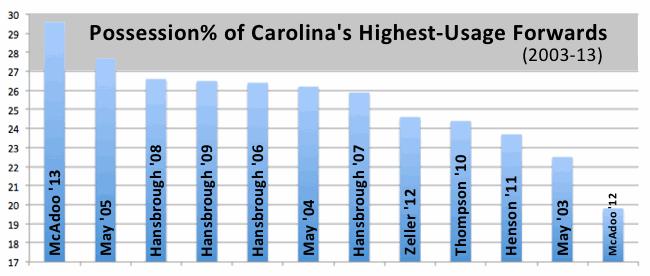Breaking down McAdoo's outsized role in North Carolina's offense
McAdoo is next in line, and after biding much of his freshman season on the bench behind Henson and Zeller, the 6-foot-9 power forward from Norfolk, Va., is averaging 16.8 points and 8.8 rebounds through six games as a sophomore. Those numbers are not surprising; McAdoo was widely branded a breakout sophomore, if not the breakout sophomore of 2012-13. What's interesting is the degree to which Carolina's offense is relying on him.
One-fifth of the way into the season -- a small, but not worthless sample size -- McAdoo is using 29.6 percent of the Tar Heels' possessions. (In a perfectly balanced offense, each starter would use 20 percent; anyone over 28 percent is considered a high-usage, centerpiece player.) Even in the seasons May and Hansbrough won their Wooden Awards, they were relied upon at lower rates.
Below is a table of the usage rates of Carolina's primary scoring forwards from 2003-2013; for the sake of comparison, I also included McAdoo's freshman-year usage rate even though he was but a minor role player.
The jump McAdoo has made from '11-12 to '12-13 -- from using 19.8 percent of possessions while he was on the floor to 29.6 percent -- is monumental. His freshman-year passiveness was due both to the personnel situation and his mindset. "We were the No. 1 team in the preseason, and our whole starting five was projected for the NBA," he said. "At first I took that to mean I was just along for a free ride -- that I wasn't necessarily needed to do much."
It took until the second half of his freshman season for McAdoo to realize, he said, "that I needed to be an integral part, and be productive even if I'm not playing 20-30 minutes". He finished with averages of 6.1 points and 3.9 rebounds in 15.6 minutes per game, but in Carolina's run to the Elite Eight, those numbers jumped to 11.8 points and 4.0 rebounds in 19.2 minutes.
That late momentum, combined with the fact that Henson, Zeller and small forward Harrison Barnes all jumped to the NBA, and that an auxiliary star has yet to emerge for the Tar Heels in 2012-13, has led to McAdoo's noticeably outsized role in the offense. If talented wings P.J. Hairston and/or Reggie Bullock can establish themselves as consistent scoring options, then the usage rates may level out and Carolina will be a more dangerous team. If not, then the McAdoo Show will roll on as he grows into the role.
A high quantity of possessions, especially for McAdoo, doesn't necessarily equal quality. All of the Tar Heels forwards that preceded him were more efficient scorers, especially in the post, where he is still a work in progress. From Synergy Sports Technology's logs, I isolated the post-up possessions for the entire careers of Thompson, Henson and Zeller, and the final three seasons of Hansbrough, and compared them with McAdoo's 107 post-up possessions from '11-12 and '12-13:
In terms of post efficiency, there is a gulf between McAdoo and Carolina's elite forwards -- in large part, he said, because he rarely ever did any back-to-the-basket work in high school. It was all new to him when he arrived in Chapel Hill.
"I'm just starting to break through and understand the ins and outs of being a post player," McAdoo said. "I struggled a lot last year, but toward the end, I found my niche, and one of the big things I've worked on is not trying to overpower everybody, and focusing on my footwork instead. I know that just because I'm posted up doesn't mean I have to back my way to the basket."
Because he's more athletic than May, Hansbrough, Henson or Zeller, McAdoo is considered by scouts to have a higher ceiling, and thus is likely to be drafted higher -- somewhere in the top five in 2013, if DraftExpress.com's mock is correct. That athleticism allows him to generate points outside of the post, such as in transition or on putbacks after offensive boards, both of which have been part of his early success. His physical abilities often help make up for his lack of polish.
As McAdoo gets ready to battle the AP poll's No. 1 team on Tuesday, remember to cut him some slack: Unlike Zeller, he was not the focal point of an offense as a freshman. McAdoo is making one of the biggest frosh-to-soph role changes of anyone in the nation.
According to Statsheet.com, through Sunday's games, there were just nine sophomores on major-conference teams with usage rates of at least 28 percent and playing-time rates of at least 50 percent. Of those nine, only McAdoo and Alabama's Rodney Cooper were making the jump from sub-20-percent role players to go-to-guys:
It's a list of players with varied profiles; at the top, Cooper and McAdoo's huge leaps in usage and minutes can be attributed to the departures of guys ahead of them on the depth chart. At the bottom are two guards who were already stars as freshmen -- Michigan's Trey Burke and Arkansas' B.J. Young. Both are becoming even more efficient as sophomores (with ORatings of 114.4 and 118.7, respectively), and the familiarity they have with those roles has to be a factor.
McAdoo's scoring efficiency (ORating: 98.4) is the second-worst of the players on the list (Georgetown's Mikael Hopkins is worst, at 91.0), but Carolina's new centerpiece was a guy who, in his words, "didn't even have to touch the ball" when he was on the floor as a freshman. McAdoo was a screener and very occasional scorer. He may need a few months to get acclimated to being the focal point of an offense.





